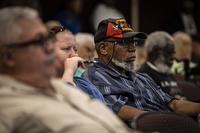Dear Sgt. Shaft,
When is VA going to recognize and expand the presumptive dates for at least those of us who served on the Korean DMZ?
Four months ago, I found out that I have Adult Diabetes Type 2, which is one of the many side effects of Dioxin exposure. I already knew many veterans who have served in Vietnam and Korea suffer from not just this side effect but many others. I have discussed with other veterans who have also served in Korea, in particular those who have also served up on the DMZ north of Freedom Bridge/Imjin-gak (River). Many of these veterans also suffer not only from Diabetes, but many of the other side effects of Dioxin exposure.
Agent Orange was used in Korea from approximately 1968 to 1971. Those that served in Korea at that time are the only ones who are acknowledged to have had exposure to Dioxin. It does not cover those that were exposed afterward, where it resides in the dirt for many years to come. From 1971 to 1991 we still had Troops running patrols, manning Guard Posts, and Observation Posts in the American Sector (11 Mile Stretch) after the use of AO.
Our final troops exited Vietnam by 1975 and they are covered in the Zone for Agent Orange. But, in Vietnam we did not naturally get a chance to see the effects of Dioxin exposure in the ground to those Veterans. In Korea, many of us believe we were exposed to it through the 70s and 80s due to aliments we now suffer from.
The US Government/VA needs to look at supporting and caring for these Veterans who are suffering from the side effects caused by exposure to Agent Orange. The Government needs to determine and accept that Dioxins remained in the area/ground well after its use and not just during. We exposed these Troops to an unsafe environment and now they suffer from it in sickness/illnesses, and in some cases death. I believe you will find in most cases, it has taken several years for the illnesses to appear, quite similar to those who were exposed to Agent Orange when it was used in Vietnam.
From 1972 to 1991, approximately 50,000 troops have served in the American Sector of the DMZ, and that is a conservative number! For the VA to see an issue/trend here is very limited due to relatively small number of veterans who have served there. With DMZ veterans spread in 50 states, territories, working, living, and retired overseas, and in some cases have passed on, it is hard to see that there is a trend/issue. That is why I ask the Veterans of Foreign Wars to stand up and help these veterans who need it now and never have been recognized for their efforts and their sickness from exposure to Agent Orange.
My son John suffers from Spinal Bifida, a birth defect from those who were exposed to Agent Orange and its Dioxins. A birth defect that is defined by the VA.
John was born on July 17, 1989 at 121st Evac Hospital, Yongsan, Korea. John's mother is Korean from the north part of the ROK. Her name is Mun, Yong-Cha!
John's spinal bifida is on record with the VA besides dealing with PTSD from Afghanistan 2009. Would I know that my service would come back to haunt him even more, then me!
John O
Via the internet
Dear John,
My sources tell me that expanding the presumptive illnesses, areas of operation, and dates for Agent Orange (AO) exposure is a difficult task. It usually takes a combined effort among the affected group, DOD, the VA and Congress to make a change. There are many groups fighting for AO coverage. Here are some suggestions for AO coverage change.
- Individual claims are technically possible but challenging. You need to work with a Veteran Service Officer. Establish a solid case with strong supporting documentation and expert testimony about how and why you were infected by the chemical in your assignment.
- If fighting for a group of Service members, work with a military or veteran organization most involved in the fight for AO coverage in their appropriate theater of operation. Some organizations may be fighting for AO exposure issues as a part of their charter. Check with organizations like AmVets, Vietnam Veterans of America, Wars, and Paralyzed Veterans of America.
- Covert operatives with no documentation may be able to check with their old commands for supporting documents. The command can’t or won’t vouch for your locations and times but can provide a general statement that may place you in the area needed for VA approval.
- If you were blue water Navy, check the VA ship registry to determine if your ship now qualifies for AO coverage.
- You can check with the National Veterans Legal Service Program to see if any legal actions are already underway.
- A final resort is working with the elected representatives of the impacted members.
• Shaft notes
The Department of Veteran Affairs (VA) announced it is continuing the process to replace its medical appointment scheduling system through an acquisition process. Today, VA is hosting pre-solicitation "Industry Day" meetings with technology vendors to discuss the Department’s upcoming scheduling system acquisition.
"Our top priority is getting Veterans off waitlists and in to see their doctors," said Acting Secretary Sloan Gibson. "We’re taking a series of immediate actions to ensure our Veterans receive the timely access to quality health care they have earned and deserve. We need lasting, long-term reforms, including a complete overhaul to replace the outdated technology for our scheduling system. Bringing an innovative scheduling product into our world-class electronic health record system is a crucial part of providing the scheduling staff in our facilities with the tools necessary to succeed. Our Veterans deserve nothing less than our best, and that’s exactly what we intend to give them."
• Send letters to Sgt. Shaft, c/o John Fales, P.O. Box 65900, Washington, D.C. 20035-5900; fax 301/622-3330, call 202/257-5446 or email sgtshaft@bavf.org.










